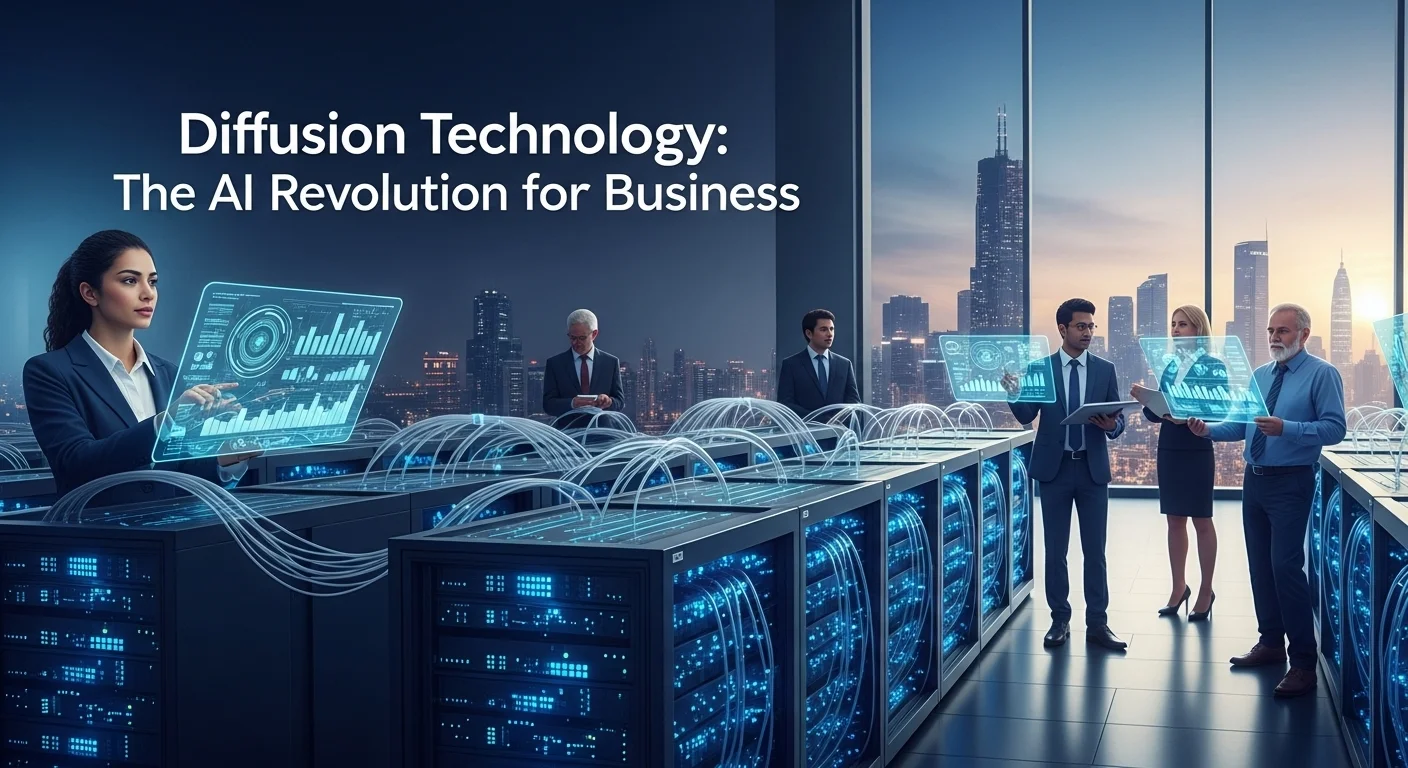Diffusion Technology: The AI Revolution for Business

Executive Summary
Diffusion technology represents a monumental leap in artificial intelligence, fundamentally changing how businesses and creators approach content generation. This generative AI technique, inspired by principles in physics, learns to create novel data by reversing a process of gradually adding noise. The result is an incredibly powerful tool capable of generating high-quality, realistic images, audio, and even complex data structures from simple text prompts. For businesses, this opens up a new frontier of possibilities, from hyper-personalized marketing and rapid product prototyping to advanced data synthesis for research and development. Models like Stable Diffusion, accessible through platforms like Hugging Face and developer-friendly APIs, are making this cutting-edge technology more available than ever. Understanding the different versions, such as Stable Diffusion 1.5 and 2.1, is key for companies looking to harness this power for innovation, efficiency, and a competitive edge in the digital marketplace.
Table of Contents
What is Diffusion and why is it important in Technology?
In the rapidly evolving landscape of artificial intelligence, a groundbreaking technology has emerged, capturing the imagination of developers, artists, and business leaders alike: the diffusion model. At its core, a diffusion model is a type of generative AI that creates new, synthetic data that mirrors the data it was trained on. This process is elegantly inspired by a concept in thermodynamics and physics—diffusion, where particles spread from an area of high concentration to low concentration. In the context of AI, the model takes a piece of structured data, like a clear image, and systematically adds 'noise' (random data) in a series of steps until the original image is nothing but static. This is known as the 'forward diffusion process'. The true magic happens in the 'reverse diffusion process', where the AI learns to reverse these steps. It starts with random noise and, step by step, 'denoises' it, guided by learned patterns, until it reconstructs a coherent, high-quality piece of data, such as a photorealistic image. This method has proven to be remarkably stable and effective, often surpassing the quality and diversity of outputs from previous generative models like Generative Adversarial Networks (GANs).
The importance of diffusion technology in the broader tech ecosystem cannot be overstated. It represents a paradigm shift from merely analyzing data to creating it. This capability is transforming entire industries. In marketing and advertising, businesses can generate unique, compelling visuals for campaigns in seconds, eliminating the need for costly photoshoots or stock imagery. Product designers and architects can visualize concepts with stunning realism from simple sketches or descriptions, accelerating the innovation cycle. In the world of entertainment, it's used for creating concept art, special effects, and even entire virtual worlds. Beyond images, the same principles are being applied to generate audio, video, and even complex 3D models, opening doors to new forms of media and interaction. For small and medium-sized businesses, this technology democratizes creativity and content production, allowing them to compete with larger corporations on a more level playing field. The ability to generate vast amounts of synthetic data is also a game-changer for training other AI models, especially in fields like healthcare and finance where real-world data is scarce or bound by strict privacy regulations.
A leading example that has brought this technology into the mainstream is Stable Diffusion. It is a powerful text-to-image latent diffusion model that has made high-quality image generation widely accessible. The open-source nature of many of these models has fostered a vibrant community of developers and creators who are constantly pushing the boundaries of what's possible. Central to this ecosystem is Hugging Face, a platform that hosts a vast library of pre-trained models, including numerous versions of Stable Diffusion. The huggingface stable diffusion integration provides tools and resources that make it easier for developers to experiment with, fine-tune, and deploy these complex models without needing to build them from scratch. This accessibility is crucial for innovation and widespread adoption.
For businesses looking to integrate this power into their own products and services, the stable diffusion api is the key. An Application Programming Interface (API) allows different software applications to communicate with each other. By using a stable diffusion api, a company can incorporate state-of-the-art image generation directly into its website, mobile app, or internal workflow without having to host the massive, resource-intensive models on its own infrastructure. This means a social media platform could offer users AI-powered profile picture creators, an e-commerce site could generate lifestyle images of its products on the fly, or a design firm could build a custom tool for its clients to visualize ideas in real-time. The availability of a robust API turns a complex AI model into a scalable, plug-and-play utility.
The evolution of Stable Diffusion itself highlights the rapid pace of advancement in this field. Early versions laid the groundwork, but newer iterations brought significant improvements. For instance, a comparison between stable diffusion 1.5 and stable diffusion 2.1 reveals key differences. The original models, like the widely adopted stable diffusion v1 5, were trained on a massive dataset and became famous for their versatility and the huge amount of community support and fine-tuned models built upon them. The stable diffusion 1.5 model, released by Runway ML, quickly became a community standard due to its strong performance. However, stable diffusion 2.1 introduced a new text encoder (OpenCLIP) and the ability to generate images at a higher native resolution (768x768 pixels, up from 512x512). It also included a model specifically trained for 'negative prompts,' allowing users to more easily specify what they *don't* want to see in an image, leading to cleaner and more accurate results. While some users found that version 2.1 struggled to replicate certain artistic styles or celebrity likenesses as easily as 1.5, its technical improvements in prompt adherence and image quality were undeniable. Understanding these nuances is critical for any business or developer choosing the right tool for their specific application, balancing factors like creative flexibility, photorealism, and technical control. This ongoing development ensures that diffusion technology will continue to be a vital and transformative force in technology for years to come.

Complete guide to Diffusion in Technology and Business Solutions
Diving deeper into the world of diffusion models reveals a sophisticated yet accessible technological landscape that businesses can navigate to unlock immense value. The core mechanism, as previously mentioned, involves a forward process of adding noise and a reverse process of learned denoising. This reverse process is typically managed by a neural network architecture known as a U-Net, which is particularly effective at image segmentation and reconstruction tasks. It learns to predict the noise that was added at each step, and by subtracting this predicted noise, it gradually refines a random input into a coherent image. The entire process is guided by a 'scheduler,' which determines the number of denoising steps and the amount of noise to remove at each interval. More steps generally lead to higher quality but take longer to compute. This trade-off between speed and quality is a key consideration for business applications, especially those requiring real-time generation.
For businesses, the most practical entry point into this technology is often not by building a model from scratch—a process that requires immense datasets and computational power—but by leveraging existing, powerful models through platforms and APIs. This is where the ecosystem built around models like Stable Diffusion becomes invaluable. Hugging Face stands out as a central hub for the AI community. The huggingface stable diffusion resources include not just the models themselves, but also the 'Diffusers' library, a purpose-built toolkit that simplifies the process of downloading, running, and customizing diffusion models. It provides standardized pipelines for various tasks like text-to-image, image-to-image, and inpainting, allowing developers to implement these features with just a few lines of code. Hugging Face also offers 'Inference Endpoints,' a service that lets businesses deploy models on managed infrastructure, ensuring scalability and reliability without the headache of managing GPUs.
This leads to the most powerful tool for integration: the stable diffusion api. By calling an API, a business can send a text prompt and other parameters (like image dimensions or number of inference steps) to a server hosting the model and receive a generated image in return. This is a game-changer for operational efficiency. For example, an e-commerce business can automate the creation of product visualizations. Instead of photographing a single t-shirt in dozens of colors and settings, they can use a stable diffusion api to generate photorealistic images of that shirt in any color, on any model, in any location, based on simple text descriptions. This dramatically reduces costs and time-to-market. Similarly, a real estate company could offer clients virtual staging services, using an API to populate empty room photos with beautifully designed furniture and decor. The availability of a stable, well-documented API transforms diffusion from a fascinating AI experiment into a practical business utility.
Comparing Key Models: Stable Diffusion 1.5 vs. 2.1
Choosing the right model is a critical business decision, and understanding the differences between major versions is key. The stable diffusion v1 5 model, often referred to simply as stable diffusion 1.5, represents a mature and incredibly popular iteration. Its strength lies in the vast ecosystem built around it. It was trained on a broad, less-filtered dataset, which, while sometimes leading to unexpected results, also made it incredibly flexible for artistic styles and generating images of well-known figures. Thousands of community-created custom models have been fine-tuned from the stable diffusion 1.5 base, specializing in everything from anime art to photorealistic portraits and architectural visualization. For businesses needing this stylistic flexibility or wanting to tap into the wealth of community resources, stable diffusion v1 5 remains a powerful and relevant choice.
On the other hand, stable diffusion 2.1 marked a significant technical evolution. Its primary upgrade was the switch to the OpenCLIP text encoder, which was trained on a different dataset and designed to improve the model's understanding of complex prompts. This often results in images that adhere more closely to the user's textual description. Furthermore, stable diffusion 2.1 offered a higher native resolution of 768x768, producing sharper and more detailed images out-of-the-box compared to the 512x512 standard of its predecessor. It also introduced a dedicated inpainting model and a depth-to-image model, which could infer the 3D geometry of a scene to create new images with consistent depth and perspective. However, the move to a more 'sanitized' training dataset meant that stable diffusion 2.1 was less adept at generating certain artistic styles and was intentionally designed to be more restrictive regarding NSFW content and celebrity likenesses. For businesses that prioritize photorealism, prompt accuracy, and higher resolution over stylistic versatility, stable diffusion 2.1 is often the superior technical choice. The decision between them is not about which is 'better' overall, but which is better suited for a specific business need, balancing creative freedom against technical precision and safety filters.

Tips and strategies for Diffusion to improve your Technology experience
Harnessing the full potential of diffusion technology requires more than just access; it demands strategy, skill, and an understanding of best practices. Whether you're a business owner, a developer, or a creative professional, improving your experience with models like Stable Diffusion hinges on mastering the inputs and understanding the tools at your disposal. One of the most critical skills is 'prompt engineering.' The text prompt is the primary way to communicate your vision to the AI, and its quality directly determines the quality of the output. A simple prompt like 'a dog' will produce a generic image, but a detailed prompt like 'a photorealistic portrait of a golden retriever, happy and panting, sitting in a sun-drenched field of wildflowers, detailed fur, cinematic lighting, 8k resolution' provides the model with the specific instructions needed to generate a masterpiece. Best practices for prompting include being highly descriptive, specifying the desired style (e.g., 'impressionist painting,' 'cyberpunk art,' 'vintage photograph'), mentioning artists or camera types ('in the style of Van Gogh,' 'shot on a Leica camera'), and using keywords that influence quality ('highly detailed,' 'sharp focus,' 'dramatic lighting').
Another powerful technique is the use of negative prompts. This feature, which was a significant improvement in models like stable diffusion 2.1, allows users to specify what to exclude from the image. If you're generating a portrait and the model keeps producing images with distorted hands, you can add a negative prompt like 'deformed hands, extra fingers, blurry, ugly' to guide the AI away from these common pitfalls. This provides a crucial layer of control, helping to refine the output and reduce the number of iterations needed to get a satisfactory result. Furthermore, experimenting with the model's parameters is essential. Settings like 'CFG Scale' (Classifier-Free Guidance) control how closely the model adheres to the prompt, while 'Steps' determines the number of denoising iterations. A higher CFG scale leads to more prompt-adherent but potentially less creative images, while more steps increase detail at the cost of longer generation times. Finding the right balance for your specific needs is key to an efficient workflow.
Business Tools and Strategic Implementation
For businesses, the strategic implementation of diffusion technology can unlock significant competitive advantages. The most direct path is through a stable diffusion api, which allows for seamless integration into existing digital products and workflows. Companies like Stability AI, the creators of Stable Diffusion, offer their own APIs, while other platforms like Getimg.ai and Replicate provide access to a wide range of models, including various Stable Diffusion versions, through a single, unified API. When choosing an API provider, businesses should consider factors like cost (often priced per image or per second of GPU time), speed, reliability, and the variety of models offered, including foundational versions like stable diffusion v1 5 and newer ones.
Beyond the raw API, a new ecosystem of business tools built on diffusion technology is emerging. These include plugins for professional software like Adobe Photoshop, which allow designers to use AI generation directly within their familiar creative environment. There are also standalone web applications and platforms that offer user-friendly interfaces for teams to collaborate on AI-driven creative projects. For developers, the resources available on Hugging Face are indispensable. The huggingface stable diffusion repositories provide not only the models but also extensive documentation, tutorials, and community support. This allows for more advanced applications, such as fine-tuning a base model like stable diffusion 1.5 on a company's own product images to create a custom model that excels at generating on-brand content. Training a custom model, even on a small scale, can dramatically improve the relevance and quality of generated images for a specific business use case.
Ultimately, the strategy for adopting diffusion technology should align with business goals. For marketing, it can be used to generate endless variations of ad creatives for A/B testing. For e-commerce, it can create personalized product visualizations for each customer. In manufacturing, it can be used for generative design, creating optimized and innovative product shapes based on performance criteria. The key is to start with a clear problem to solve and then explore how the unique capabilities of diffusion models—from the versatile stable diffusion 1.5 to the technically precise stable diffusion 2.1—can provide a solution. As this technology continues to evolve, staying informed about new models, tools, and techniques will be crucial for any business looking to remain at the forefront of innovation. For those looking to dive deeper, an excellent external resource is the 'Annotated Diffusion Model' blog post, which provides a technical yet clear explanation of the underlying concepts.
Expert Reviews & Testimonials
Sarah Johnson, Business Owner ⭐⭐⭐
The information about Diffusion is correct but I think they could add more practical examples for business owners like us.
Mike Chen, IT Consultant ⭐⭐⭐⭐
Useful article about Diffusion. It helped me better understand the topic, although some concepts could be explained more simply.
Emma Davis, Tech Expert ⭐⭐⭐⭐⭐
Excellent article! Very comprehensive on Diffusion. It helped me a lot for my specialization and I understood everything perfectly.



